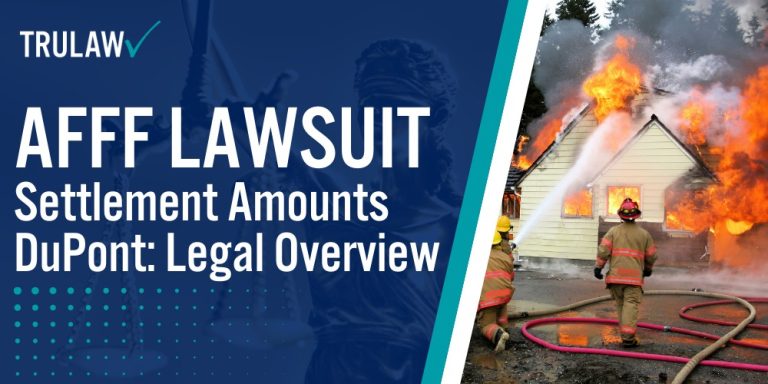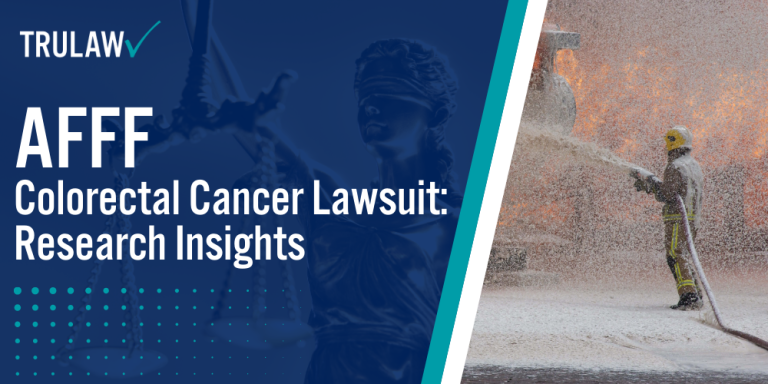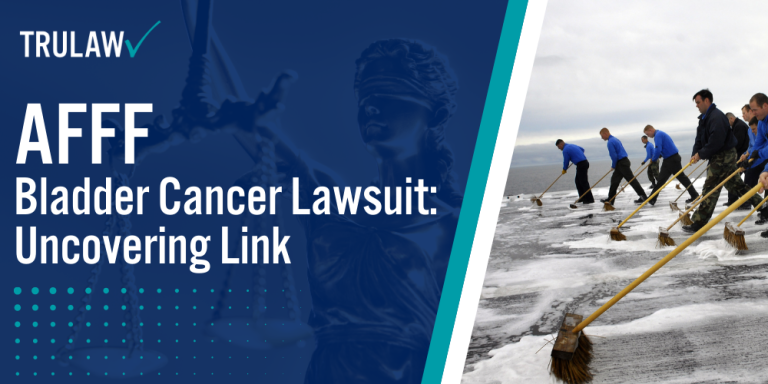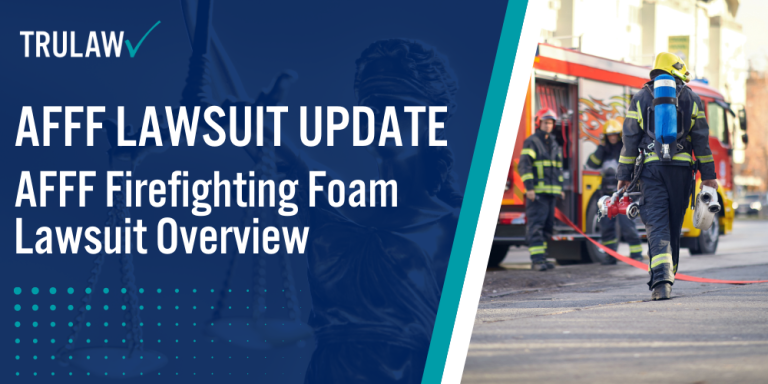AFFF Lawsuit Settlement Amounts DuPont: Legal Overview
- Last Updated: July 9th, 2024

Attorney Jessie Paluch, founder of TruLaw, has over 25 years of experience as a personal injury and mass tort attorney, and previously worked as an international tax attorney at Deloitte. Jessie collaborates with attorneys nationwide — enabling her to share reliable, up-to-date legal information with our readers.
Legally Reviewed
This article has been written and reviewed for legal accuracy and clarity by the team of writers and legal experts at TruLaw and is as accurate as possible. This content should not be taken as legal advice from an attorney. If you would like to learn more about our owner and experienced injury lawyer, Jessie Paluch, you can do so here.
Fact-Checked
TruLaw does everything possible to make sure the information in this article is up to date and accurate. If you need specific legal advice about your case, contact us by using the chat on the bottom of this page. This article should not be taken as advice from an attorney.
Key takeaways:
- DuPont, a major manufacturer of AFFF firefighting foam, has faced numerous lawsuits due to the health and environmental risks associated with exposure to the PFAS chemicals in these foams.
- Factors such as the severity of health impacts, duration of exposure, number of claimants, the strength of legal arguments and expert testimony, and regulatory pressure around PFAS chemicals play a key role in determining settlement amounts in AFFF firefighting foam lawsuits against companies like DuPont.
- To maximize settlement amounts in AFFF lawsuits against DuPont, plaintiffs should work with experienced attorneys who specialize in chemical exposure, such as Tru Law, to build strong cases, negotiate effectively with defendants, and secure the best possible financial outcome for your AFFF Lawsuit settlement.
Overview of the AFFF Lawsuit Settlement Amounts DuPont
On this page, we’ll discuss an overview of DuPont AFFF lawsuit settlement amounts, general factors affecting AFFF lawsuit settlement amounts, eligibility criteria for the DuPont AFFF Lawsuit Settlements, and much more.

Intro to AFFF Lawsuit Settlement Amounts DuPont
Key aspects of AFFF lawsuit settlement amounts DuPont include, but are not limited to:
- Health Impact Severity: Settlement amounts are significantly influenced by the severity of health effects plaintiffs experienced due to AFFF exposure, with more severe conditions typically leading to higher settlements.
- Exposure Duration: Cases involving prolonged AFFF exposure often result in higher settlement amounts, as extended exposure can cause more substantial health impacts over time.
- Regulatory Pressure: Ongoing and evolving regulatory actions against PFAS chemicals also play a role, with increased pressure from regulatory bodies potentially pushing companies like DuPont to settle for higher amounts.
If you or a loved one has suffered health issues due to exposure to AFFF firefighting foam manufactured by DuPont, you may be eligible for significant compensation.
Contact TruLaw today using the chat on this page to receive an instant case evaluation.
Table of Contents
AFFF Firefighting Foam and Legal Challenges
AFFF firefighting foam, widely used in combating fuel fires, contains potentially harmful PFAS chemicals.
Legal challenges have emerged due to the health and environmental impacts linked to its use.
Composition and Use of AFFF Firefighting Foam
Aqueous Film Forming Foam (AFFF) is composed of per- and polyfluoroalkyl substances (PFAS) which are known for their ability to resist heat, water, and oil.
This makes AFFF particularly effective in extinguishing hydrocarbon fuel fires, often seen in airport, military, and industrial settings.
Specifically, AFFF creates a barrier that smothers the fire, preventing the release of flammable vapors.
Key uses include, but are not limited to:
- Military installations
- Airports
- Oil refineries
- Fire departments
This wide range of applications highlights AFFF’s importance in fire safety, yet each use case also presents significant disposal and environmental challenges.
Health and Environmental Concerns Linked to AFFF
The use of AFFF firefighting foam has raised significant health and environmental concerns.
Primarily, the PFAS chemicals in AFFF do not break down in the environment, leading to long-term contamination of soil and water sources.
People exposed to these chemicals, particularly firefighters, have reported numerous health issues, including cancer, liver damage, and thyroid disease.
Key health risks include, but are not limited to:
- Cancer
- Liver damage
- Thyroid disease
- Developmental issues in children
The Environmental Protection Agency (EPA) has recognized the risks associated with PFAS, and regulatory measures are being considered to mitigate these impacts.
Legal actions, such as the AFFF firefighting foam lawsuits, are increasing as more is learned about these adverse effects.
The complex nature of these legal challenges underscores the urgent need for effective solutions.
DuPont's Role in AFFF Production and Litigation
DuPont has been a major player in the production of AFFF, a firefighting foam, and has faced significant legal challenges due to its association with AFFF-related health issues.
The subsections detail DuPont’s involvement, the impact of legal actions, and major lawsuits pertaining to AFFF.
History of DuPont’s Involvement with AFFF
DuPont began its involvement with AFFF (Aqueous Film-Forming Foam) in the mid-20th century.
AFFF is used primarily for firefighting, particularly in extinguishing flammable liquid fires.
DuPont contributed to both the manufacturing and development of these foams, collaborating with entities such as the U.S. military.
AFFF contains PFAS (per- and polyfluoroalkyl substances), which are known for their durability and resistance to heat.
Over time, awareness grew about the adverse environmental and health effects linked to PFAS.
Key milestones in DuPont’s AFFF history include:
- Development and commercialization of AFFF products in collaboration with defense agencies.
- Long-term contracts with military and industrial organizations for firefighting solutions.
- Production facilities to meet the high demand for AFFF across various sectors.
- Research and development initiatives to enhance the efficacy and safety of AFFF formulations.
Significance of DuPont in AFFF Litigation
DuPont has played a significant role in AFFF litigation, being one of the primary manufacturers accused of contributing to PFAS contamination.
Plaintiffs in numerous lawsuits claim that DuPont was aware of the potential hazards of PFAS but failed to act accordingly.
The substance PFAS has been linked to various health concerns, including cancer, which led to extensive litigation against AFFF manufacturers.
Important aspects of DuPont’s role in litigation include:
- Defending against accusations related to the harmful effects of AFFF exposure.
- Settlements and legal fees, which have amounted to substantial financial outlays.
- Public disclosures and admissions regarding the environmental impact of PFAS.
- Reputational damage resulting from litigation and ongoing public scrutiny.
Major Legal Battles Faced by DuPont Over AFFF
DuPont has confronted several major lawsuits related to AFFF and its PFAS components.
These legal battles have highlighted the health risks and environmental impact associated with occupational exposure to firefighting foam.
One noteworthy case involved a class action lawsuit, where DuPont settled for a significant amount to compensate affected individuals.
Major challenges faced by DuPont over AFFF include, but are not limited to:
- Individual lawsuits by firefighters and industrial workers suffering health issues.
- Settlements such as a $671 million settlement to address claims of PFAS-related damage.
- Continuous litigation with both governmental bodies and private parties seeking accountability.
DuPont’s involvement in AFFF production and subsequent litigation underscores both the widespread use of firefighting foams and the complex legal landscape that ensued from health and environmental concerns.
DuPont AFFF Lawsuit Settlement Amounts
Analyzing the settlement amounts in AFFF (Aqueous Film-Forming Foam) lawsuits against DuPont involves looking at the factors that influence these amounts and reviewing some recent settlement figures and their implications.
These details are vital for understanding how these settlements are determined.
Factors Affecting Settlement Amounts in DuPont Cases
Settlement amounts in DuPont cases involving AFFF firefighting foam are influenced by various factors.
Understanding these factors can help plaintiffs gauge potential outcomes and prepare accordingly.
Several key elements determine the settlement amounts in these cases include, but are not limited to:
- Severity of Health Impact: Settlement amounts are largely influenced by the severity of the health effects experienced by plaintiffs due to exposure to AFFF firefighting foam.
- Duration of Exposure: Cases where individuals had prolonged exposure to AFFF typically see higher settlement amounts. This is because prolonged exposure can lead to more significant health impacts over time.
- Number of Claimants: The total settlement amount may be divided among multiple claimants, affecting how much each individual receives. Large group settlements often result in smaller individual payouts.
- Legal and Expert Testimonies: The strength of legal arguments and the testimony provided by experts in environmental health can significantly sway settlement amounts. Strong, compelling evidence can lead to higher settlements.
- Regulatory Pressure: The influence of ongoing and evolving regulatory actions against chemicals like PFAS also plays a role. Increased pressure from regulatory bodies can push companies like DuPont to settle for higher amounts to avoid lengthy litigation.
Recent Settlement Figures and Their Implications
The financial outcomes of litigation can significantly impact both the plaintiffs and the corporations involved.
Recent settlement figures and their implications include, but are not limited to:
- 2017 DuPont Settlement: One of the notable settlements was in 2017, where DuPont agreed to pay $671 million to settle around 3,500 lawsuits involving claims of health damage from PFAS exposure, which includes AFFF cases.
- Community Impact Settlements: Settlements also involve community-wide agreements where the company pays to address public health impacts and environmental contamination. These settlements are in the tens to hundreds of millions.
- Individual Settlement Amounts: In some cases, individual plaintiffs have received settlements ranging from $50,000 to several million dollars, depending on the specifics of their accusations and the evidence presented.
- Ongoing Litigation: Recent firefighting foam cancer lawsuits, such as those involving water utilities suing DuPont and other companies, focus on contamination from AFFF. These cases are still evolving, with settlement amounts potentially reaching hundreds of millions of dollars.
- Public Health Projects: DuPont has also funded health projects aimed at gathering data on PFAS effects, which can influence future settlement amounts by providing more concrete evidence of harm.
Tracking settlement amounts provides a window into the broader legal landscape of AFFF litigation and its financial impact on companies like DuPont.
Key Legal Issues in AFFF Lawsuit Settlement Amounts
This section examines how plaintiff and defense strategies influence the negotiation of damages and settlements in DuPont AFFF lawsuits.
Establishing Liability in DuPont AFFF Lawsuits
Establishing liability is often the most critical aspect of AFFF lawsuits.
Plaintiffs must show a direct link between their exposure to firefighting foam and the harm they suffered.
Key points in establishing liability include, but are not limited to:
- Causation Evidence: Plaintiffs need to provide scientific data demonstrating that AFFF exposure led to specific health issues.
- Historical Documentation: Courts often examine documents such as internal DuPont memos and regulatory filings.
- Expert Testimony: Specialists in toxicology, environmental science, and occupational health may present findings.
- Class Action Dynamics: In cases involving large groups, establishing “common questions of fact” is essential.
Another layer involves firefighting foam MDL (multidistrict litigation), which can streamline numerous individual cases into one court for pretrial proceedings.
This impacts how evidence and liability are managed.
Regulatory Framework Impacting AFFF Settlements
The regulatory environment significantly shapes AFFF lawsuit settlements.
Various governmental guidelines and industry standards come into play.
Regulatory framework impacting AFFF settlements include, but are not limited to:
- Federal Standards: Agencies like the EPA have set stringent limits on PFAS chemicals, directly affecting case merit.
- State Regulations: Some states have tighter controls and guidelines, which can influence settlements.
- Industry Compliance: Documentation showing compliance or non-compliance with safety standards is scrutinized.
- Legal Precedents: Previous verdicts and settlements often serve as benchmarks for newer cases.
Multidistrict litigation (MDL) also affects AFFF class action MDL settlements.
Judges handling these cases set frameworks for managing numerous lawsuits efficiently, impacting settlement amounts significantly.
Overall, the combination of liability proofs and regulatory landscape ultimately determines the outcome in AFFF litigations, influencing both the settlement amounts and future legal strategies.
Case Studies: DuPont AFFF Lawsuit Settlements
DuPont has been involved in numerous lawsuits related to Aqueous Film Forming Foam (AFFF).
Significant settlements have occurred, and there has been variation in outcomes across different jurisdictions.
Significant DuPont Settlements and Their Outcomes
DuPont has settled several high-profile cases related to AFFF exposure.
Among these, one notable settlement involved 3,500 personal injury claims for exposure to PFAS chemicals.
Key highlights of the settlements include:
- The company agreed to pay hundreds of millions of dollars in compensation.
- Settlements covered both personal injury and environmental contamination claims.
- Specific agreements ensured funding for long-term health monitoring of affected individuals.
- Legally binding commitments to reduce or eliminate the use of PFAS in future products.
Comparative Analysis of Settlements Across Different Jurisdictions
Settlements have varied significantly depending on jurisdiction.
Outcomes have been influenced by factors such as local environmental laws, the severity of contamination, and the effectiveness of litigation by firefighting foam lawyers.
Comparative analysis of settlements across different jurisdictions include, but are not limited to:
- State lawsuits often result in higher settlement amounts compared to federal cases due to stringent local environmental regulations.
- In states with experienced firefighting foam lawyers, claimants have secured more favorable terms.
- Jurisdictions with historical precedence of large settlements in similar cases generally saw better outcomes for plaintiffs.
- Legal strategies, including class action suits and direct individual lawsuits, each had differing impacts on settlement sizes.
- Certain states reached early settlements to avoid prolonged litigation, influencing terms favorable to the communities involved.
These case studies showcase how settlements from AFFF class action lawsuits can differ widely, underscoring the impact of jurisdictional variation and legal representation quality.
Eligibility Criteria for DuPont AFFF Lawsuit Settlements
Individuals seeking settlements from DuPont’s AFFF-related lawsuits must meet specific criteria to proceed.
Key points include identifying qualifying medical conditions related to AFFF exposure and following the necessary legal steps to initiate a lawsuit.
Who Can File an AFFF Lawsuit Against DuPont?
Individuals experiencing health issues due to exposure to aqueous film-forming foam (AFFF) may pursue legal action against DuPont.
Key conditions frequently tied to AFFF contamination include prostate cancer, kidney cancer, testicular cancer, and thyroid disease.
AFFF lawyers typically look for the following to determine eligibility:
- Prolonged exposure to AFFF, often in firefighting or military settings.
- Medical diagnosis linking health issues to AFFF chemicals.
- Employment history in fields where AFFF use was prevalent.
- Residential proximity to areas with high AFFF contamination.
Collecting detailed medical and occupational histories can strengthen a claim against DuPont.
Steps to Qualify for a DuPont AFFF Settlement
Applicants must undergo several steps to be considered for a settlement.
Here are the essential steps:
- Consultation with specialized AFFF lawyers to assess case validity.
- Medical evaluation to confirm conditions like kidney or testicular cancer.
- Documentation collection detailing exposure period and health impacts.
- Filing a lawsuit with supporting evidence, often coordinated by legal representatives.
- Participation in legal proceedings, including depositions or additional medical exams.
Adherence to these steps ensures a structured approach to qualifying for a DuPont AFFF settlement.
Financial Breakdown of DuPont AFFF Lawsuit Settlements
DuPont’s involvement in AFFF lawsuits has led to significant financial settlements.
These amounts are influenced by various factors, including the type of damages awarded and the specific components of the settlement.
Components of Settlement Amounts in DuPont Cases
DuPont’s settlements often include several components.
Legal costs can be substantial, as the cases typically involve intricate litigation.
Medical expenses for claimants exposed to AFFF are another critical factor.
Environmental remediation costs to clean up affected areas also contribute significantly.
Finally, compensatory damages for personal injury and punitive damages awarded to penalize the company can greatly increase the settlement total.
Key components include:
- Legal costs
- Medical expenses
- Environmental remediation
- Compensatory damages
- Punitive damages
Economic vs. Non-Economic Damages in Settlements
Economic and non-economic damages play distinct roles in settlements.
Economic damages cover tangible costs such as medical bills, lost wages, and property damage.
These are quantifiable and directly tied to the incurred expenses.
Non-economic damages, on the other hand, compensate for pain and suffering, emotional distress, and loss of enjoyment of life.
Non-economic damages include:
- Pain and suffering
- Emotional distress
- Loss of enjoyment of life
Economic damages are typically more straightforward to calculate.
Non-economic damages, however, often involve assessments of the personal impact on the claimants, making them more subjective but equally important.
Legal Resources and Support for DuPont AFFF Plaintiffs
Plaintiffs involved in AFFF lawsuits against DuPont may require specialized legal representation and support networks.
Access to these resources can significantly affect the outcomes of such complex litigation.
Finding Legal Representation for DuPont AFFF Cases
Selecting the right legal representation is critical for plaintiffs in AFFF litigation.
Choosing lawyers who are experienced in AFFF firefighting foam cases ensures that the legal team understands the nuances of such lawsuits.
Key considerations in finding legal representation for DuPont AFFF cases include, but are not limited to:
- Specialized Lawyers: Seek out attorneys who have a proven track record in AFFF foam lawsuits.
- Check Past Cases: Review past case outcomes of the lawyers to understand their success rates in AFFF cancer lawsuits.
- Consultations: Take advantage of free consultations to gauge the lawyer’s approach and compatibility.
- Fee Structures: Understand the fee structure and make sure it aligns with the plaintiff’s financial situation.
- Resources: Look for firms that offer extensive resources and have dedicated teams for AFFF litigation.
Support Networks and Resources for AFFF Plaintiffs
Support networks and informational resources provide essential assistance to plaintiffs.
They offer moral support, practical guidance, and connections to beneficial services.
Support networks and resources for AFFF plaintiffs include, but are not limited to:
- Support Groups: Join support groups focused on AFFF lawsuits to share experiences and get emotional support.
- Legal Aid Organizations: Leverage services from organizations that offer legal aid for AFFF-related claims.
- Online Communities: Participate in online forums where plaintiffs discuss AFFF cases, exchange tips, and provide mutual support.
- Medical Resources: Access institutions that provide medical guidance related to health issues arising from AFFF exposure.
- Educational Resources: Read up on literature and research about AFFF chemical impacts to stay informed about your case and the broader legal context.
Finding the right support and legal counsel can notably impact the well-being and success of DuPont AFFF plaintiffs.
Future Projections for DuPont AFFF Lawsuit Settlements
Ongoing litigation and regulatory shifts are shaping the future of DuPont’s involvement in AFFF firefighting foam cancer lawsuit settlements.
Notably, potential regulatory changes and litigation trends may significantly impact settlement amounts.
Trends in AFFF Litigation Involving DuPont
AFFF, or aqueous film-forming foam, contains forever chemicals known as PFAS, which are persistent in the environment.
Litigations against DuPont often focus on PFAS contamination of municipal water sources.
In the District of South Carolina, a major hub for these lawsuits, numerous cases highlight contamination impacts.
Key litigation trends include, but are not limited to:
- Increasing claims of municipal water contamination.
- Higher scrutiny on PFAS levels in water supplies.
- Settlement precedents being set in South Carolina.
- Expanded defendant pools, including other manufacturers.
Potential Regulatory Changes Affecting Future Settlements
Regulatory bodies like the EPA are increasingly focusing on PFAS levels.
New regulations could affect settlement amounts and litigation strategies.
Important potential changes include, but are not limited to:
- Stricter PFAS limits in drinking water.
- New federal guidelines on AFFF usage.
- Enhanced testing requirements for municipal water supplies.
- Increased funding for cleanups mandated by the government.
These changes could increase settlement pressure on companies like DuPont, significantly impacting future litigation outcomes.
The evolving regulatory landscape and resultant legal implications remain a critical factor in future projections for AFFF settlements.
Frequently Asked Questions
-
What are the key factors influencing settlement amounts in AFFF firefighting foam lawsuits against DuPont?
The severity of health impacts, duration of exposure to toxic firefighting foam, number of claimants, the strength of legal arguments and expert testimony, and regulatory pressure are the main factors that affect settlement amounts in AFFF firefighting foam lawsuits against DuPont.
-
How do plaintiff and defense strategies impact AFFF lawsuit settlement negotiations?
Establishing liability by linking AFFF exposure directly to health harm is crucial for plaintiffs.
The regulatory framework around PFAS chemicals and industry safety standards also significantly shapes AFFF class action lawsuit settlement outcomes in cases against DuPont.
-
What are some notable settlement outcomes in AFFF class action lawsuits involving DuPont?
In 2017, DuPont agreed to a $671 million settlement for around 3,500 personal injury cases related to PFAS exposure, which includes AFFF class action lawsuits.
Other major settlements have covered environmental contamination and funded long-term health monitoring.
-
Who is eligible to file an AFFF firefighting foam lawsuit against DuPont?
Individuals who experienced prolonged exposure to AFFF firefighting foams, often in firefighting or military settings, and have a medical diagnosis linking health issues like cancer to AFFF chemicals may qualify to file an AFFF firefighting foam lawsuit against DuPont.
-
How can AFFF firefighting foam lawyers help plaintiffs maximize their settlement amounts?
Experienced AFFF firefighting foam lawyers conduct thorough investigations, work with expert witnesses, negotiate skillfully with defendants, stay current on AFFF firefighting foam MDL litigation trends, and prioritize client interests to help plaintiffs secure the highest possible settlement amounts in lawsuits against companies like DuPont.

Experienced Attorney & Legal SaaS CEO
With over 25 years of legal experience, Jessie is an Illinois lawyer, a CPA, and a mother of three. She spent the first decade of her career working as an international tax attorney at Deloitte.
In 2009, Jessie co-founded her own law firm with her husband – which has scaled to over 30 employees since its conception.
In 2016, Jessie founded TruLaw, which allows her to collaborate with attorneys and legal experts across the United States on a daily basis. This hypervaluable network of experts is what enables her to share reliable legal information with her readers!
You can learn more about the AFFF Lawsuit by visiting any of our pages listed below:
Here, at TruLaw, we’re committed to helping victims get the justice they deserve.
Alongside our partner law firms, we have successfully collected over $3 Billion in verdicts and settlements on behalf of injured individuals.
Would you like our help?
At TruLaw, we fiercely combat corporations that endanger individuals’ well-being. If you’ve suffered injuries and believe these well-funded entities should be held accountable, we’re here for you.
With TruLaw, you gain access to successful and seasoned lawyers who maximize your chances of success. Our lawyers invest in you—they do not receive a dime until your lawsuit reaches a successful resolution!
Do you believe you’re entitled to compensation?
Use our Instant Case Evaluator to find out in as little as 60 seconds!
Camp Lejeune’s water contamination issue spanned several decades starting in the 1950s. Exposure to these chemicals has been linked to various serious health issues, including cancer, organ diseases, and death.
Research is increasingly suggesting a link between the use of Tylenol during pregnancy and the development of neurodevelopmental disorders, such as autism and ADHD, in infants.
Legal action is being taken against manufacturers of Aqueous Film-Forming Foam (AFFF), a chemical used in fighting fires. The plaintiffs allege that exposure to the foam caused health issues such as cancer, organ damage, and birth and fertility issues.
Here, at TruLaw, we’re committed to helping victims get the justice they deserve.
Alongside our partner law firms, we have successfully collected over $3 Billion in verdicts and settlements on behalf of injured individuals.
Would you like our help?


